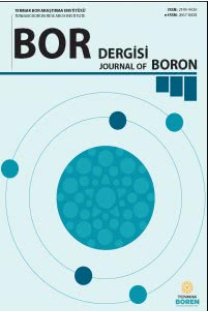Yanma Yöntemi İle Lantanit Katkılı Borat Nano Taneciklerin
Bu çalışmada farklı lantanitler (Eu,Dy,Nd) kullanarak lüminesans özellikli borat tanecikler sentezlenmiştir. Lantanit katkılı lüminesans maddelerin sentezlenmesi için kolay, ucuz ve verimli olan yanma yöntemi kullanılmıştır. Sentezlenen maddelerde Fotolüminesans (PL) spektroskopisi yöntemi kullanılarak katkılanan lantanitlerin, tuzak derinliklerinin ve (aktivatör ve ko-aktivatörlerin) derişimlerinin ışıma şiddeti üzerine etkisi incelenmiştir. Yapısal analizler X ışını kırınımı (XRD), FTIR, Taramalı Elektron Mikroskobu (SEM) analizleri ile yapılmıştır. Farklı aktivatörlerin katkı oranlarına göre, kristal yapı ve bileşiklerin sönüm süreleri incelendiğinde, her bir aktivatörün, farklı katkı oranlarının ışıma ve sönüm sürelerini etkilediği ortaya konmuştur. Her bir bileşik için optimum oranlar belirlenmiştir. Sentezlenen maddeler arasında en iyi ışıma şiddetine sahip maddeler için yapılan sönüm süresi çalışmaları sonucundan ışıma şiddetinin en yüksek değerleri için sönüm süresinin de buna bağlı olarak daha uzun olduğu görülmüştür.
Anahtar Kelimeler:
Lüminesans, Borat, Lantanit
Yanma Yöntemi ile Lantanit Katkılı Borat Nano Taneciklerin Sentezi ve Lüminesans Özelliklerinin İncelenmesi
In this work, luminescent borate particles were synthesized using different lanthanides (Eu, Dy, Nd). An easy, inexpensive and efficient combustion method has been used to synthesize lanthanide-doped luminescent materials. The effects of photoluminescence (PL) spectroscopy on the radiant intensities of lanthanides, trap depths and activators and co-activators were investigated in the synthesized materials. Structural analyzes were performed by X-ray diffraction (XRD), FTIR, Scanning Electron Microscopy (SEM) analyzes. When the damping times of the crystal structure and the compounds are examined according to the addition ratios of the different activators, it has been revealed that each activator influences the afterglow time and decay curve of the different additive ratios. Optimum ratios were determined for each compound. It was observed that the lifetime for the highest values of long lasting afterglow intensity as a result of the lifetime time studies for the substances having the best long lasting afterglow among the synthesized substances is accordingly longer.
Keywords:
Lüminesans Borat, Lantanit, combustion,
___
- [1]. Diaz, A., Keszler, D.A., Chem. Mater., 9, 2071, 1997. [2]. Wu. L, Chen X. L. Xu Y. P., And Sun Y. P. “Structure Determination and Relative Properties of Novel Noncentrosymmetric Borates MM’4(BO3)3 (M=Na, M’=Ca and M=K,M’=Ca, Sr)” Inorganic Chemistry, 45 No.7., 2006. [3]. Pekgozlu I., Erdogmus E., Cubuk E., Basak A.S. “Synthesis and photoluminescence of LiCaBO3:M (M:Pb2+ and Bi3+) phosphor” Journal of Luminescence 132, 1394-1399, 2012. [4]. Rulmont A., Almou A., Spectrochim. Acta 45A (5) 603, (1989) [5]. Bhagat S.P, Gawande A.B, Omanwar S.K, Photoluminescence study of a novel UV emitting phosphor Sr2Mg(BO3)2:Pb2+,Gd3+, Optical Materials, 40, 36-40, 2015. [6]. Martın O. Onani, Joseph O. Okil, Francis B. Dejene, “Solution-combustion synthesis and photoluminescence properties of YBO:Tb3+ phosphor powders” Physica. [7]. Bajaj N.S., Omanwar S.K., “Combustion synthesis and luminescence characteristics of NaSr4 (BO3)3:Tb3+” Journal of Luminescence 148, 169-173, 2014. [8]. Qiao X, Cheng Y, Qin L, Qin C, Cai P, Kim Sun I, Seo H.J, Coprecipitation synthesis, structure and photoluminescence properties of Eu3+ doped sodium barium borate, Journal of Alloys and Compounds, 617, 946-951, 2014. [9]. Zhang X, Seo H J, Luminescence properties of novel NaBa4(BO3)3:Ce3+, Eu3+Phosphors, Physica B, 406, 77-79, 2011. Yashashchandra D, Shyam Baha
- ISSN: 2149-9020
- Yayın Aralığı: Yılda 4 Sayı
- Başlangıç: 2016
- Yayıncı: TENMAK Bor Araştırma Enstitüsü
Sayıdaki Diğer Makaleler
Bilge Yaman, Nurcan Çalış Açıkbaş
The nanobiocomposites synthesis from biomass and its characterization
Nuran AY, Emir Zafer HOŞGÜN, Berrin BOZAN, Yapıncak GÖNCÜ
Dry sliding behaviour of boron waste reinforced epoxy matrix composites
Nurcan ÇALIŞ AÇIKBAŞ, Bilge YAMAN
Potential for using borate mixtures as groundline preservative pastes
Selim UYSAL, Jed CAPPELLAZZİ, Jeffrey J. MORRELL
Yanma Yöntemi İle Lantanit Katkılı Borat Nano Taneciklerin
Selim UYSAL, Jed CAPPELLAZZİ, Jeffrey MORRELL
Duygu YILMAZ, Umut SAVACI, Nurşen KOÇ, Servet TURAN
ÜLEKSİT VE BORAKS İÇEREN FREN SÜRTÜNME MALZEMELERİNİN TRİBOLOJİK ÖZELLİKLERİ
